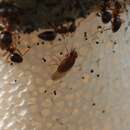tr
kırıntılardaki isimler


Zaprionus Coquillett, 1902 is a drosophilid genus characterized by the presence of longitudinal white stripes on the frons and the mesonotum. These stripes are structural, consisting of long grooved trichomes that reflect the light.[1] It is a Paleotropical genus whose species are classified under two subgenera: Zaprionus in the Afrotropical region (50 spp.), and Anaprionus in the Oriental and Australasian regions (12 spp.).[2] Recently, two of its Afrotropical species became invasive, namely Zaprionus indianus Gupta, 1972 and Zaprionus tuberculatus Malloch, 1932, with cosmopolitan and subcosmopolitan distributions, respectively.[3][4] In Tropical Africa, most species breed on ripe fruits but some are flower breeders.[5] Phyogenetic analyses show the genus to be polyphyletic, with some species of the subgenus Anaprionus being more related to other drosophilid genera than to the subgenus Zaprionus.[6][7]